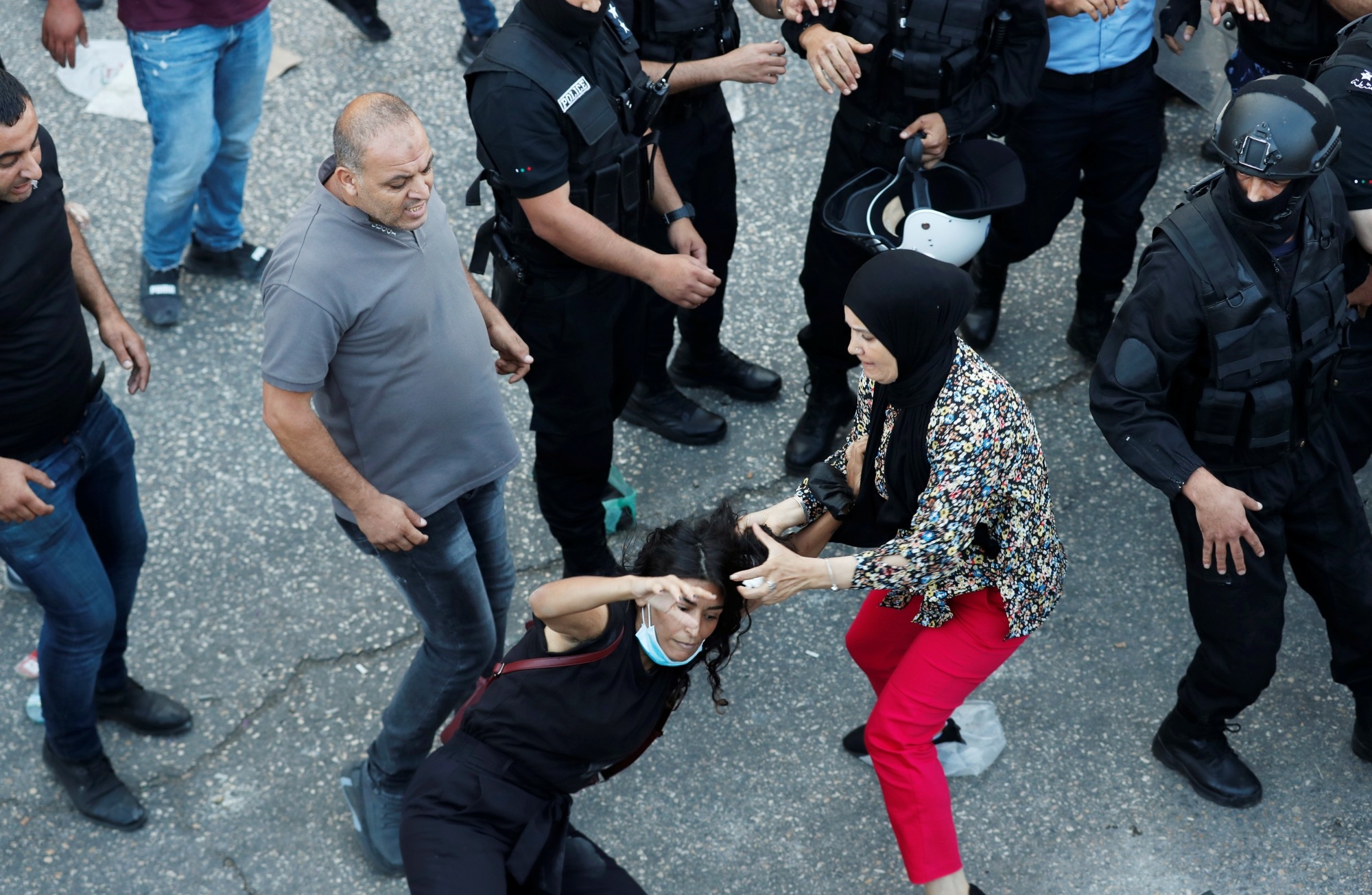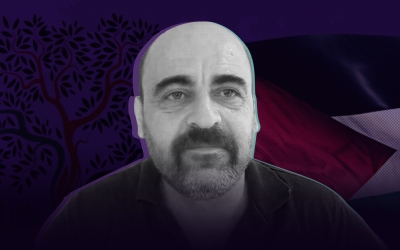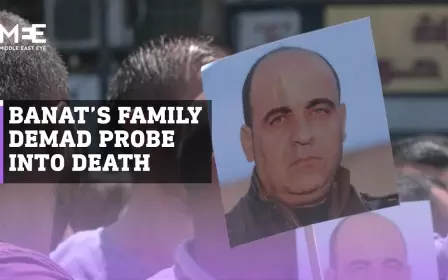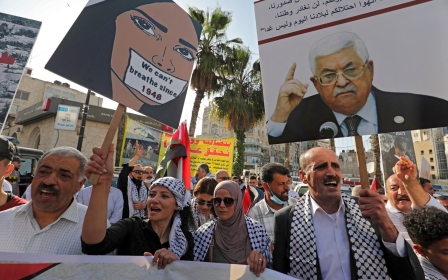Nizar Banat killing: Witnesses recount Palestinian Authority's violent crackdown on protests

The death of Nizar Banat, a prominent critic of the Palestinian Authority (PA), while in the custody of PA security forces last week, sent a shockwave among Palestinians and ignited widespread anger against President Mahmoud Abbas.
For five days, thousands marched in Ramallah, Hebron, Bethlehem and other occupied West Bank cities, demanding justice for Banat and calling for the overthrow of the PA.
The protests were met with a security crackdown that peaked on Sunday, according to eyewitnesses, with Palestinian security forces attacking demonstrators, beating journalists and deliberately targeting women and human rights workers.
"We stood there shocked at what was happening," Giusara Nakhleh, an eyewitness, told Middle East Eye. "We were watching horrific scenes of young men and women being dragged and beaten."
Nakhleh, who was standing near the protests in Ramallah on Sunday, said that she saw some 30 security officers in plainclothes attacking a protester, severely beating him as the young man tried to reach a safe area.
"When he reached the safe area where we were standing, they started beating us all," Nakhleh said.
"I was physically harassed and could not defend myself," she said. "I don't know how many were assaulting me, in addition to the insults and obscene language they used."
The incident, far from isolated, showed a troubling pattern of deliberate violence levied by Palestinian security forces in the face of popular discontent.
Two days of violence
The crackdown by PA security and intelligence officers was particularly violent in Ramallah, the administrative capital of the PA.
On Saturday, riot police and undercover officers violently dispersed a march heading towards the Muqataa - a guarded compound housing several government buildings, including the president’s office.
Plainclothes officers spread out among protesters, beating and dragging several people on the ground.
As protesters approached the intersection leading to the Muqataa, riot police launched a heavy barrage of tear gas and sound grenades into the crowd.
At least four journalists reported being deliberately attacked and assaulted.
On Sunday, the crackdown escalated, with the complete withdrawal of riot police from the city centre.
In their stead, counter-rallies in support of Abbas took place, while dozens of undercover officers, mostly masked and wearing black, intensified their attacks on demonstrators.
Protesters were attacked with batons and pepper spray, and phones were seized from people trying to document the crackdown.
Attacks on media
Attacks on media crews, especially women journalists, were a prominent feature over the two days.
Plainclothes officers threatened and surrounded press crews near Ramallah’s clock tower roundabout on Saturday, preventing them from moving closer to the protests.
A number of journalists were beaten or otherwise injured, their equipment broken and phones confiscated.
Aziza Nofal, a freelance journalist working with several international media outlets, said attacks on journalists included threats, physical assaults, and verbal abuse.
"There was a clear targeting of female journalists," Nofal said. "They targeted us as women to intimidate other journalists."
Fellow Palestinian journalists Fayhaa Khanfar and Naglaa Zaitoun were severely beaten by plain-clothed officers on Saturday, leaving bruises and fractures all over their bodies.
'They humiliated me. I couldn't find anyone to defend me'
- Ahmed Talaat, Palestinian photojournalist
Saja al-Alami, another journalist, was chased down for a long distance before she managed to hide in a public bathroom.
Ahmed Talaat, a photojournalist covering the protests in Ramallah, told MEE that he too was attacked despite wearing a press vest.
"As soon as I arrived, I received threats not to film," Talaat said. "I did not bow to them. I continued filming, then they attacked me severely."
Talaat was beaten by a group of officers, who notably targeted his face and caused bruises and marks across his body.
The freelance journalist said he had been injured several times in the past by the Israeli army while covering news, but this was different.
"This is very painful for me. They humiliated me. I couldn't find anyone to defend me," Talaat said.
Field researchers working with monitoring and human rights groups were also targeted. Meanwhile, MEE witnessed security forces harassing members of the Office of the United Nations High Commissioner for Human Rights, who were wearing UN vests.
"We are asking for a guarantee to practice our journalistic work to cover events and to play a monitoring role against the attacks on public freedoms," Nofal said.
Targeting of women
Over the two-day crackdown, several women who participated in the rallies told MEE they were subjected to physical harassment by security forces.
Rita Ammar, a demonstrator who joined the Saturday rallies in Ramallah, said a group of officers beat her severely even after the crowds had been dispersed.
"We fled and hid in a commercial building, and after the crackdown ended, we went out," she said. "At that moment, plain-clothed men began to attack us. We were hit with batons, dragged and kicked.
"I received heavy blows, especially on my stomach, and I could not get up and control myself," she added. "People managed to get me away from them before the ambulance took me."
Ammar said she underwent examinations for more than five hours between Ramallah Hospital and Istishari Hospital to ensure her internal organs were not grievously damaged.
Thankfully, she said, "the beating did not cause fractures or bleedings - but it caused a lot of pain."
Activist Aghsan al-Barghouthi told MEE that the level of repression levied by the PA, including direct targeting of demonstrators with sound bombs and physical assault and harassment of women, was expected by the Palestinian Authority’s security apparatus.
"The doctrine, structure and purposes of the PA security services are not based on protecting the Palestinian people, but rather repressing them if they try to challenge its existence," Barghouthi said.
The scale of the widespread anger against the PA in the aftermath of Banat’s death shocked the PA, Barghouthi said, which is what led to the heavy-handed crackdown approach.
"The PA feels that its entire existence is threatened, which is why it's intensifying its crackdown and it is why they killed Nizar Banat."
"They see the solution in smashing heads and instilling fear in the conscience of people to deter them from taking to the streets again."
This article is available in French on Middle East Eye French edition.
Middle East Eye propose une couverture et une analyse indépendantes et incomparables du Moyen-Orient, de l’Afrique du Nord et d’autres régions du monde. Pour en savoir plus sur la reprise de ce contenu et les frais qui s’appliquent, veuillez remplir ce formulaire [en anglais]. Pour en savoir plus sur MEE, cliquez ici [en anglais].






